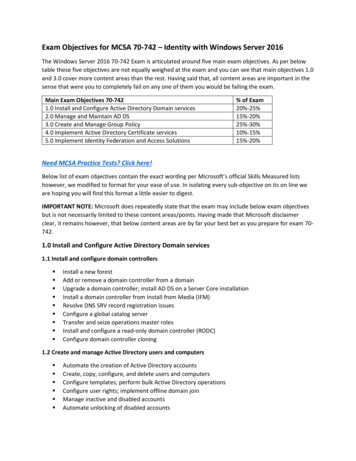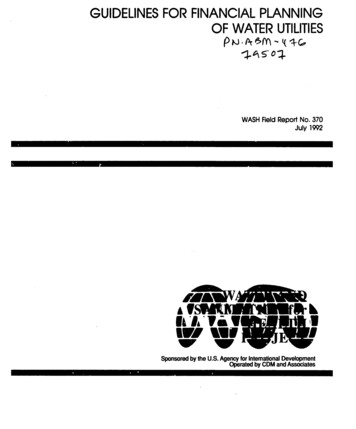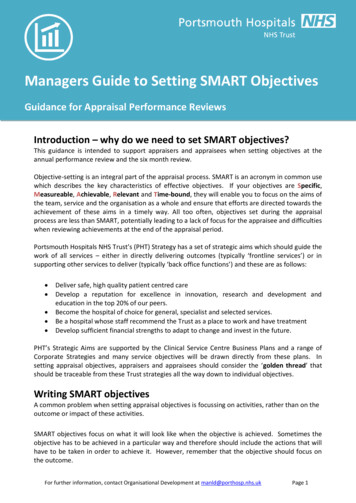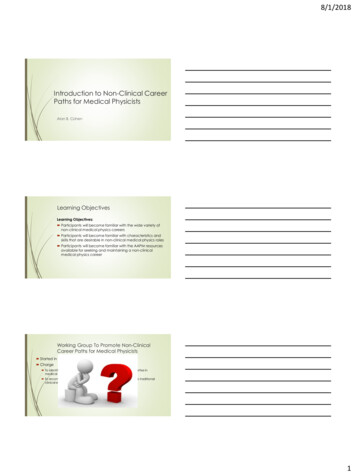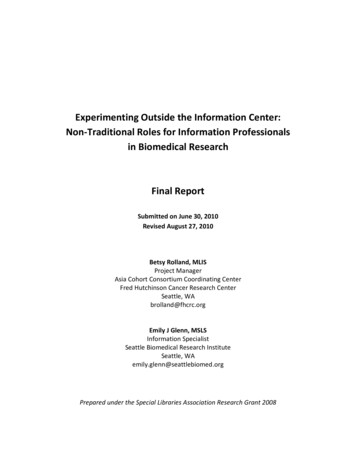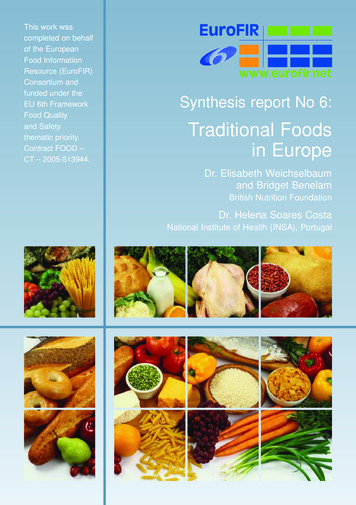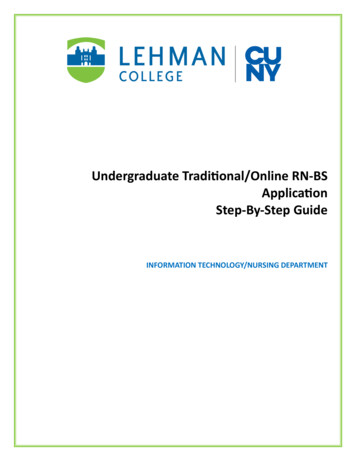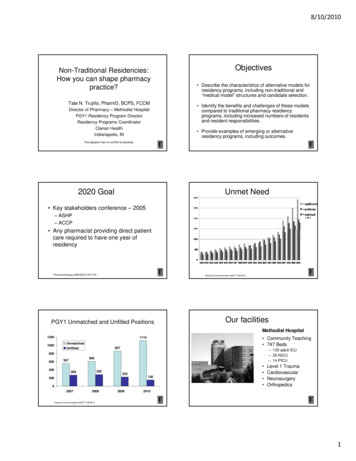
Transcription
8/10/2010Non-Traditional Residencies:How you can shape pharmacypractice?Tate N.N Trujillo,Trujillo PharmDPharmD, BCPSBCPS, FCCMDirector of Pharmacy – Methodist HospitalPGY1 Residency Program DirectorResidency Programs CoordinatorClarian HealthIndianapolis, INObjectives Describe the characteristics of alternative models forresidency programs, including non-traditional and“medical model” structures and candidate selection. Identify the benefits and challenges of these modelscompared to traditional pharmacy residencyprograms, including increased numbers of residentsand resident responsibilities. Provide examples of emerging or alternativeresidency programs, including outcomes.The speaker has no conflict to disclose.2020 GoalUnmet Need Key stakeholders conference – 2005– ASHP– ACCP Any pharmacist providing direct patientcare required to have one year ofresidencyPharmacotherapy 2006;26(5):722–733.Personal Communication ASHP 7/30/2010PGY1 Unmatched and Unfilled PositionsOur facilitiesMethodist Hospital120010001114UnmatchedUnfilled Community Teaching 747 Beds857– 130 adult ICU– 35 NICU– 14 PICU8006004006055572822692222001500200720082009 Level 1 sonal Communication ASHP 7/30/20101
8/10/2010Our facilitiesIndiana University Hospital Academic Medical Center370 BedsHematology / OncologySolid Organ TransplantHepatologyPractice ModelOur facilitiesRiley Hospital for Children Pediatric University Teaching 247 Beds Pediatric Level 1 Trauma and Burn Clinical specialist Decentralized pharmacists Satellites––––critical care – MH/IUpediatrics – MHOR satellite – IUoncology - RI Central pharmacy Automation: Decentralized distribution throughADC Medication order transmission via electronicsenderClarian Health PharmacyResidencies 13 – PGY1 2 – Two yearpharmacotherapy 9 – PGY2––––––––Critical CareInfectious DiseasesPediatricsOncologyInternal MedicineDrug InformationInformaticsTrauma / Critical Care 27Potential Future Programs PGY1 – BallPGY1 – BloomingtonPGY2 – Ambulatory CarePGY2G– Emergency MedicinePGY2 – NutritionPGY2 – Practice ManagementPGY2 – Transplant 3 – Non-Traditional PGY12
8/10/2010Application ProcessInitial Program Goals Increase the number of PGY1 trainedpharmacist Career advancement Modeled after non-traditionalnon traditional PharmD program Maintain the same . . . as traditional PGY1– Structure– Organization– Standards Doctor of Pharmacy from an ACPEaccredited school Clarian pharmacist for at least 6 month priorto application Application Deadline October 15th Identical application materials as fortraditional program Offer made to the top ranked candidate One position per yearRotationsProgram Structure 12 one-month rotationsMaximum of 4 rotations in calendar yearCoordinated with operation managerLongitudinal experience occur in 6 monthconsecutive blocksOrientationPractice ManagementDrug InformationA rotation that meets each of thefollowing:– Critical Care– Infectious Diseases– Pediatrics– Surgery– Medicine– Ambulatory care– Case conference at the collegeOther Learning Experiences Grand RoundsPharmacy ReportResidency ForumqPortfolio RequirementsMUELongitudinal ProjectResidency Class ExperiencesTeaching Certificate Program (elective)Residency TimelineEventTraditionalNon-traditionalProject IdeaFirst week of AugustFirst week of 2ndrotationProject ProposalpresentationFirst week of SeptemberPrior to 3rd rotationQuarterly EvaluationsSep/Oct, Dec/Jan, Mar,JunEvery 3 rotationsMUEDecember6th month3
8/10/2010What’s Different?Benefits Increase qualified individuals Recruitment and retention Strengthens relationships within thedepartmentp Shorter orientation Continue with normal every thirdweekend schedule Maintain staff salary Time-off allowance duringresidency– Residents– Generalist– Specialist– LeadershipStaff Development?Similarities Enhances skills Enhances knowledgeDifferences NTR: More systematic NTR: More diverse– Drug Information– Administration– Project Management– Teaching Expectations– Program– ResidentBeginning a NTR Develop a traditional programKeep it the same (when possible)Non-traditional resident must take ownershipProcess for trackingg non-traditional residents’progress Insure full residency experience Selecting the “right” candidate– Bad choice – “what will this program give me?”– Good choice – “how will this program help meimprove?”OutcomesChallenges of a NTR Resident time management– Set clear expectations– Above and beyond staff expectations– Managers TOO! Scheduling issues– Longitudinal experiences– RPD and schedule writer must work together Candidate selection Operations manager2 individuals withdrewDecentral clinical pharmacistTraditional PGY2G3 individuals are current residents– Right attitude towards training– Clear expectation for what ROI will be for resident– Accepting or rejecting is more personal than withtraditional4
8/10/2010Who else is doing it?FAQ’sAllegheny General HospitalPittsburgh, PA Guaranteed residency spot?Guaranteed a clinical position?Earlyy exit from the program?p gDesire to switch to a traditionalresidency?Henry Ford HospitalDetroit, MIWashington Hospital CtrWashington, DCVAMCIndianapolis, INClarian HealthIIndianapolis,dili INKern Medical CenterBakersfield, CAJohns HopkinsBaltimore, MDOhio State Medical CenterColumbus, OHUniversity of Maryland?Baltimore, MDNon-Traditional Residencies:How you can shape pharmacypractice?Tate N. Trujillo,j , PharmD,, BCPS,, FCCMDirector of Pharmacy – Methodist HospitalPGY1 Residency Program DirectorResidency Programs CoordinatorClarian HealthIndianapolis, IN5
Director of Pharmacy - Methodist Hospital PGY1 Residency Program Director Residency Programs Coordinator Clarian Health Indianapolis, IN The speaker has no conflict to disclose. Objectives Describe the characteristics of alternative models for residency programs, including non-traditional and "medical model" structures and candidate .



